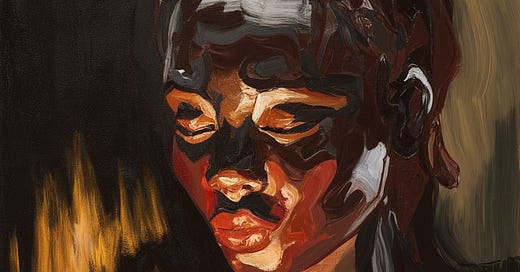Sinners, Silk, and the Sacred: Afrocentrics in Horror Media (Pt. 3)
From the archives of Verse and Vantage.
So, I understand that this coming out now may be a shock. Well, the reason for this delay is simple… it was depression. I have been handling some personal matters, so I haven’t been consistent lately. However, let’s get this back on track and wrap it up!
ON TO THE LAST PART!
What has been said so far in this trilogy post: horror was never about fear, not for us, not for the people who had to invent gods to survive the night. For Black people, horror has never been fiction, it’s just been Thursday. And maybe that’s why, when we tell horror stories, they don’t come out clean. They come out messy, erotic, grief-heavy, foft where they shouldn’t be, blasphemous, sacred, full of rhythm and teeth and unbaptized spirits that demand your attention.
This isn’t part three because I ran out of things to say. It’s part three because we’ve reached the part where I stop explaining myself. I’ve done the autopsy, traced the lineages, and pointed at the blood on the wall…
Here’s the problem with white horror: it obsesses over purity. Not just virgin sacrifices and Catholic guilt (though, yes, obviously that), but the whole moral architecture of who gets to live, who gets to die, and who gets forgiven. It’s always about whether the demon needs to be exorcised or just heard, whether you can kill the evil and restore “order.” But in Black horror—the real kind, not trauma porn with a blues soundtrack—there is no order to return to. The order was haunting.
So, what do we do instead with this epiphany and gain some understanding of black representation in horror? We ritualise. We sanctify the mess. We don’t kill the ghost—we let her braid our hair while she hums old hymns. We let the blood dry on the floor and call it evidence of love. We stop asking for resolution and start asking for rhythm.
She needs to be seen as erotic, as soft, as capable of betrayal and mythmaking and sacred pleasure. The story isn’t framed around “fixing” her. It’s framed around watching her worship herself back together. And isn’t that what every horror story should be about? Not surviving the monster, but realising you are the monster—and then lighting candles for yourself anyway?
Black people don’t believe in clean hauntings. We don’t do your tidy white sheets and “unfinished business.” For us, haunting is never a glitch. It’s an obligation, and when we do horror well (when we do it for ourselves) we don’t try to exorcise that. A lush, intimate, uncomfortable performance space where pleasure and grief wear the same outfit and no one apologises for it. Something passed down through flesh and instead of trying to “resolve” the haunting, the film absorbs it. It lets the characters be changed by it, seduced by it. That’s the kind of haunting I recognise. The kind that doesn’t want an ending—it wants acknowledgement.
White horror completely chokes when it comes to the body. More specifically, the Black body. It either wants to punish it (through violence), purify it (through death), or erase it (through neglect). But Black horror? Black horror touches it. It says: yes, you feel that. yes, you wanted that. yes, even in the middle of all this blood and mourning, you wanted someone’s hand on your thigh. And that doesn’t make you weak.
There is a kind of erotic tension in Afrocentric horror that isn’t just sexual—it’s spiritual. The silk in the title isn’t costume design. It’s the fabric of seduction and softness and vulnerability, wrapped tight around people who are constantly told not to feel. It becomes a theological argument, proof that you can want, even after everything. That desire doesn’t have to be a distraction. It can be a ritual. Black femme bodies, especially, have always been sacred sites of horror and holiness. We’ve just never been allowed to write the prayer books, but now it’s time to write something your mother wouldn’t read aloud but would recognise anyway. That’s the kind of horror I want. The kind where a scream can be mourning or pleasure—or both—and nobody asks you to pick.
So what happens when Blackness authors horror without filter, without permission, without trying to make it digestible for an A24 trailer audience? You get something feral. Something that doesn't survive the genre—it devours it and spits out bones wrapped in silk. You get work like Sinners, like Interview With The Vampire (2022), like Nanny, like His House, like Candyman (the real one, not the moral fable). Stories that are not about escaping horror but embodying it. Black horror is not and should not be called a subgenre. It is not an aesthetic. It is a spiritual jurisdiction. Saturation with grief. With scent. With longing. With memory. Where horror is not something that “happens to us.” And that’s what I mean by re-sacralization (not the return to something pure, but the claiming of something profane). The right to write monsters that look like us and don’t die at the end. The right to be messy. And to make meaning from that mess.
So this is where we close the circle.
We began with the idea that Black horror is ancestral. It carries memory and myth. It deserves softness and rage. Now we leave with something deeper: the knowing that horror isn’t just a genre for us. It’s a language of return. It’s how we talk to our dead. It’s how we touch each other in the dark. It’s how we make silk out of blood.
And listen—if that doesn’t make it sacred, I don’t know what to do.
Anyway, thanks for coming to my SubstackTalk.
Catch me outside, still black, still woman, and still me.



